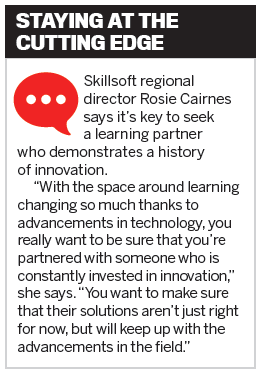Developing a culture of learning within the workplace is integral to continued business innovation – and easier than ever, thanks to the power of technology
.jpg)
Developing a culture of learning within the workplace is integral to continued business innovation – and easier than ever, thanks to the power of technology
Traditionally, training, learning and development have been the domain of senior management. Companies have typically been willing to invest in the upskilling of their top team members and then rely on the trickle-down effect to ensure that other staff reap the (secondhand) benefits.
Given the cost that can be involved in training, this has been an understandable approach, but it isn’t necessarily effective. Not all managers are gifted communicators, and if staff move on there’s also the potential for knowledge to be lost before it’s been passed on – not to mention the risk that important information can become garbled during transmission.
Fortunately, recent years have seen a greater shift towards providing training to a broader variety of staff. Organisations now see greater value in providing additional training to employees before they reach a senior position, better equipping them for their roles in the process. Many of these changes have been driven by technology, which enables greater access to learning resources at a more cost-effective rate.
“Classroom-style learning is a valuable tool, but it naturally means the instructor has to limit their attention to a select few students. It’s also not cost-effective for businesses,” says Rosie Cairnes, regional director of Skillsoft (Australia & New Zealand). “But as technology continues to evolve and o er greater ease of access, there’s been a greater democratisation of learning.”
Though the emphasis has often been on further developing existing ‘leaders’, in the modern workplace virtually everyone is a leader of some sort, Cairnes says. Yet this mindset is still in the process of filtering into the Australian work landscape; it’s a process Cairnes is passionate about hastening.
“Everyone’s a leader of their own domain, and so you need to be thinking about leadership development,” she says. “You’ve got to not just think about your top tier but what’s happening with your frontline.”
Workplace learning in a digital age
One of the great positives about utilising technology for learning delivery is that it is not confined to physical structures or instructor-to-peer ratios. Accordingly, it can enable organisations to reach a far greater number of employees, providing them with ongoing training as the nature of their roles changes.
Still, not all technology is created equal. Cairnes stresses that businesses should be looking for a partner, rather than a provider, when instituting learning solutions.
“You should be seeking a partner who can understand the unique business issues that you’re trying to resolve, while also demonstrating results and impact,” says Cairnes. “The organisations who are really willing to partner effectively tend to get the best results, and I don’t think that’s a coincidence.”
In Skillsoft’s case, learning is delivered by Percipio’s Embedded Learning Synchronized Assistant (ELSA). With access to the award-winning intelligent learning platform via a browser plug-in, the experience is available for all users throughout their workday, within their natural workflow.

“As technology continues to evolve and offer greater ease of access, there’s been a greater democratisation of learning” Rosie Cairnes, regional director of Skillsoft (Australia & New Zealand)
Percipio has also been designed to be an open learning platform that enables organisations to access curated content, including proprietary resources and assets from other sources. It has highly flexible deployment options and can operate on its own or be integrated with HRIS and learning management systems. Additionally, it is device agnostic, allowing staff to access training on the device that best suits them – particularly helpful in a world where BYOD is becoming the norm.
This integration of learning into the workday is particularly crucial; it’s estimated that most staff dedicate around 1% of their working week to development. To break it down further, that equates to around 24 minutes a week. It’s a small window of opportunity for staff, and accordingly the learning solution needs to have a formula that speaks to the modern learner.
Still, this doesn’t mean there’s no place for longer-form training.
“We take the view that micro learning on its own doesn’t serve every occasion,” says Cairnes. “You need to have a micro and macro approach to delivering up learning so you can deal with the moment of need but you can also provide something more structured if the need calls for it.”
Additionally, people have different learning needs, which must be factored in when making a decision about platforms and partners. Skillsoft provides a variety of learning types that can be drawn on to service a relevant teaching situation. Employees may benefit from a role-play scenario or discussion panel or by hearing from a thought leader. Conversely, the relevant message may be equally effectively conveyed through an animation or by following how-to instructions.
“You can’t just spit out a learning formula that treats all subjects in exactly the same fashion,” says Cairnes. “We take the view that you’ve got to have a varied treatment according to subject and moment of need for the learner.”

Still, having all the tools in place will be for naught if the right atmosphere for learning isn’t also present.
For businesses who are seeking further training for their staff, it’s crucial to establish a culture of learning. This must have innovation at its core, and a clear vision that staff and senior management alike can grasp easily. But it’s not as simple as placing “learning culture” in the company’s mission statement and hoping that things flow from there. Staff need to be made aware that learning is something the organisation actually values and views as a priority.
Similarly, it must be clearly demonstrated that the training is relevant and useful for staff. Learning solutions must be aligned to the larger goals and targets of the business, with a clear agenda outlined as to why a learning culture matters. The future of work demands skills based around problem-solving, decision-making and critical thinking, along with having a basic understanding of disruptive technologies that are impacting the way we work and our experiences, such as the internet of things, machine learning, blockchain and artificial intelligence. Employees must be convinced of the practical benefits to their current and future roles in order to ensure their full (and effective) participation.
“Marketing is key for conveying this message at a critical-mass level,” says Cairnes. “The organisation needs to raise awareness about why a learning culture is really important, and that really comes from management.”
In addition to spearheading the marketing around a new learning culture, management must also clearly demonstrate their commitment to it. This can be manifested in a variety of ways: avid reading habits, regularly participating (or leading) learning, providing recommendations for resources, etc. Perhaps most importantly, their e orts must be visible to other staff, to help set an example of expectations. While many staff are eager for learning, no one wants to feel like their boss doesn’t take the exercise seriously.
“Senior management sometimes give the impression that they think learning is something that needs to happen for everyone but themselves,” says Cairnes. “But learning needs to be something quite intrinsically personalised for everybody, and something that everybody engages with.”
Implementing such a culture can be a lengthy and involved process, but it’s increasingly necessary. Companies that can provide their employees with not only the tools they need to perform their tasks but also the opportunity to enhance their existing skills are more likely to retain staff for longer and make a more valuable contribution to their industry.









